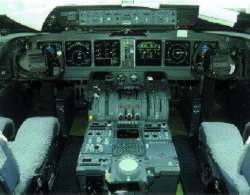FRANCES FIORINO/NEW YORK
The Transportation
Safety Board of Canada is assessing safety benefits of
independent standby systems on MD-11s that would serve as a
"get-home package" in the event of aircraft electrical
failure.
 Pilots transitioning to standby systems in adverse
circumstances could be "significantly hampered" if those
instruments are not in standard layout, according to the
Transportation Safety Board advisory.
Pilots transitioning to standby systems in adverse
circumstances could be "significantly hampered" if those
instruments are not in standard layout, according to the
Transportation Safety Board advisory. |
The move comes out of the safety board's ongoing probe of
Swissair
Flight 111, an MD-11 that crashed Sept. 2, 1998, near
Peggy's Cove, Nova Scotia. The aircraft experienced an
inflight fire while en route from New York JFK to Geneva.
In recent weeks, investigators sent a Safety Advisory
letter to parties of the probe outlining potential safety
problems posed by the layout of standby instrumentation and
inadequacies of crew training on those systems.
The advisory asks parties to consider a review of the
current Canadian and U.S. Federal Aviation Regulations that
cover requirements for standby instrumentation as well as
training regulations and practices to ensure crews obtain
adequate skills in the use of standby systems.
THE CANADIAN SAFETY Board describes how operation
of standby systems might have added to the substantial
workload of the Flight 111 crew struggling to handle a dire
emergency. Shortly after the flight crew reported smoke in
the cockpit, they had to deal with diversion--at night--to
an unfamiliar airport, Halifax International.
While the crew was wearing oxygen masks and smoke was
permeating the cockpit, the autopilot disengaged and other
systems-related failures occurred, some which affected
primary instrument displays. The advisory states that there
were indications that standby instruments were in use.
Shortly after the crew declared an emergency, ATC lost
communication with Flight 111, and the MD-11's transponder
ceased functioning.
When required, under both CAR 605.41 and FAR 121.305, an
aircraft standby attitude indicator must be plainly visible
to and usable by any pilot from his station. The advisory
states that pilots must be able to quickly adjust the
instrument cross-check "T" scan when switching to standby
systems. "In adverse circumstances [the transition] could be
significantly hampered" by having the instruments positioned
away from the normal line of vision and by not having them
in standard layout. This could lead to disorientation of the
crew and loss of aircraft control.
In the accident aircraft, the magnetic compass, or
alternate direction of flight instrumentation, was
positioned in a standard location for transport aircraft--at
the top of the windshield on the left side of the center
post. However, its position in relation to the standby
instruments for attitude, altitude and airspeed--located
just above the center pedestal--might have added to the
crew's difficulties.
The layout would have required a pilot to scan a
"considerable" vertical distance, meaning the use of
up-and-down head movements, to complete a cross-check--which
in turn would increase the chances of disorientation,
according to the advisory. The letter adds that the
challenge of using standby instruments is greater for crews
who either are not well trained or have not had recent
practice in their use.
Regulations also state the standby attitude indicator
(AI) must be powered from a source independent of the
electrical generating system. In the accident aircraft, the
AI is powered from battery bus, which is independent. There
is no requirement, however, for standby instruments to
remain powered by an independent power supply separate from
the aircraft electrical system and battery, according to the
advisory.
THE ADVISORY STATES
Swissair modified the standby flight
instrument equipment in its aircraft following the crash of
Flight 111. The carrier installed a secondary flight display
system (SFDS) on its MD-11s that is similar in layout to the
primary flight display. The SFDS has an auxiliary battery to
supply power for a minimum of 45 min.
The parties to the investigation may voluntarily fulfill
the safety board's requests to review regulatory
requirements outlined in the advisory. If investigators
discover other evidence that may require further action, the
board would issue a safety recommendation.